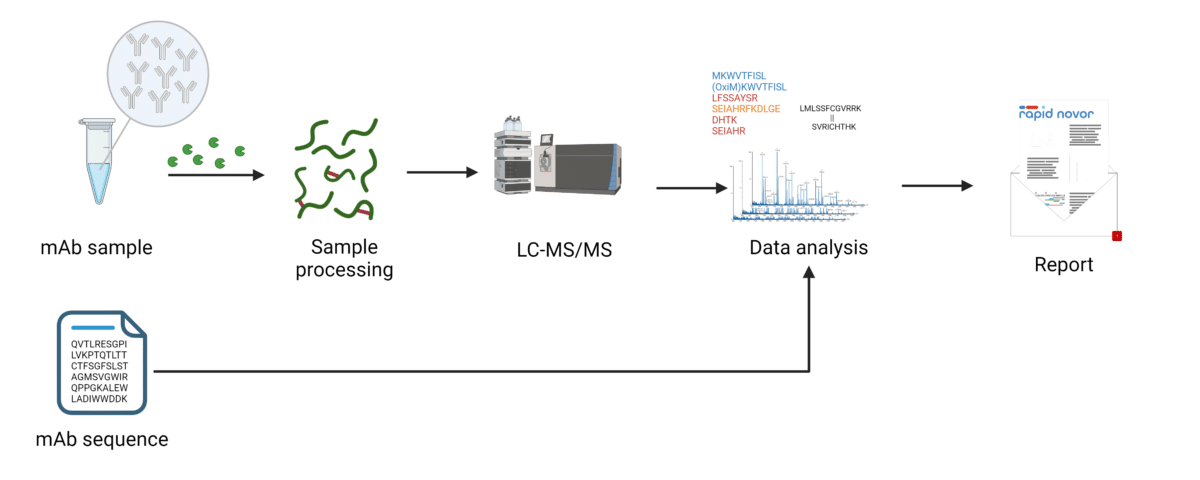Disulfide Bond Analysis.
Identification and quantification of disulfide bonds by LC-MS, designed for monoclonal antibodies (mAbs).
How Disulfide Bond Analysis Works.
Disulfide bonds play an important role in stabilizing the spatial structure of proteins, maintaining correct folding conformation, maintaining and regulating their biological activities. The formation of disulfide bonds forces the amino acid residues in different regions of the same or different peptide chains to converge together, so that the peptide chains quickly fold and form a stable spatial topology.
HPLC-MS/MS is a powerful tool for protein characterization due to its high sensitivity, high accuracy and abundant structural information. The common method of disulfide bond analysis by mass spectrometry is analyzing the protein digest mixtures after enzymatic digestion, then identifying the type and location of disulfide bonds. We typically use trypsin and chymotrypsin digested non-reduced samples, which are then separated by Liquid Chromatography and analyzed by tandem mass spectrometry (MS/MS).

Talk to Our Scientists.
We Have Sequenced 10,000+ Antibodies and We Are Eager to Help You.
Through next generation protein sequencing, Rapid Novor enables reliable discovery and development of novel reagents, diagnostics, and therapeutics. Thanks to our Next Generation Protein Sequencing and antibody discovery services, researchers have furthered thousands of projects, patented antibody therapeutics, and developed the first recombinant polyclonal antibody diagnostics.
Why Disulfide Bond Analysis Matters.
Disulfide bonds form between pairs of cysteines and they join the parts of an antibody together. In antibody engineering, a modified antibody sequence may not have the desired disulfide bonds present. The bond may form between the wrong cysteines some of the time. Discovery scientists and protein engineers may analyze disulfide bond shuffling in order to select or reject mAbs for downstream work. Production teams who have access to this information early in their process can have higher success rates downstream.
Getting Started.
Requirements
- Amino acid sequence(s) in FASTA format
- 50 μg per analysis per sample
- >90% purity
- Monoclonal antibody (any isotype, format or fragment)
Deliverables
- Table of identified peptides with disulfide bond linkages
- Sequence annotated with disulfide bonds
- XIC, MS1 and MS2 spectra
- Optional: Prevalence of each disulfide bond configuration (percentage)
- Optional: comparison of samples, if multiple samples are given
Timeline
Screening
“High quality, reliable work, exceeding expectations.”
– JJ, Protein Science Consultant
(Disulfide Bond Analysis Project)
Talk to Our Scientists.
We Have Sequenced 9000+ Antibodies and We Are Eager to Help You.
Through next generation protein sequencing, Rapid Novor enables timely and reliable discovery and development of novel reagents, diagnostics, and therapeutics. Thanks to our Next Generation Protein Sequencing and antibody discovery services, researchers have furthered thousands of projects, patented antibody therapeutics, and ran the first recombinant polyclonal antibody diagnostics
Talk to our scientists. We have sequenced over 9000+ antibodies and we are eager to help you.
Other Antibody Characterization Services.
Peptide Mapping
Match the masses of individual peptides to the expected masses from a given sequence, maximizing sequence coverage and confidence.
Explore our LC-MS Peptide Mapping Service
Intact Mass Analysis
Determine the mass of the whole antibody or its sub-units to explore a variety of characterization applications.
Explore our Antibody Intact Mass Analysis Service
Glycosylation Analysis
Find glycosylation site occupancy, and profile their relative abundance %. Compare many samples.
Explore our Glycosylation Analysis LC-MS Service
Rapid PTM Analysis
Locate, identify and quantify post-translational modifications. Compare between samples.
Explore our PTM Analysis LC-MS Service
Sequence Variant Assessment
Identify and quantify variants of your intended antibody within your sample, and consider other contaminants.
Explore our SVA Analysis LC-MS Service
Disulfide Bond Analyses
Analyse peptides cross linked by disulfide bonds. Quantify disulfide bond shuffling in engineered constructs.
Explore our Disulfide Bond Analysis LC-MS Service
DAR Analysis
Determine the ratio of antibody to payload in ADC development.
Explore our Drug-Antibody Ratio Analysis Service
Antibody Sequencing, Discovery and Characterization Services.
Antibody Sequencing & Discovery Services.
REmAb® mAb Sequencing
Monoclonal antibody sequencing from small antibody samples, no need for hybridoma or DNA information. Full sequence in record time.
Explore Antibody Sequencing Services
REpAb® pAb Sequencing
Polyclonal antibody sequencing and antibody discovery service. Sequence antibodies from blood or a polyclonal mixture.
Explore Antibody Discovery Services
RapidSPR™ Analysis
Label-free evaluation of antibody-antigen binding using surface plasmon resonance on Biacore or Nicoya. Can be employed for detailed kinetic profiling, kinetics screening, or epitope binning.
Explore SPR Services
RapidHDX-MS™
Mass spec based epitope mapping. Epitope mapping for identify the binding site of an antibody to its corresponding antigen with the highest confidence and resolution.
Explore HDX-MS Epitope Mapping Service
MATCHmAb™
Antibody verification by rapid peptide mapping. Antibody sequence confirmation and full detailed mapping for development purposes.
Explore Peptide Mapping Service
Antibody Characterization
LC-MS analysis for study of antibody glycosylation, disulfide bonds, post-translational modifications, sequence variants, intact mass and size.
Explore Antibody Characterization Services

